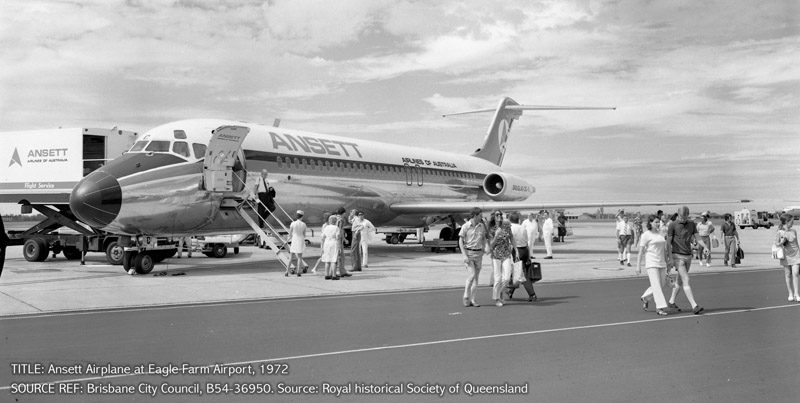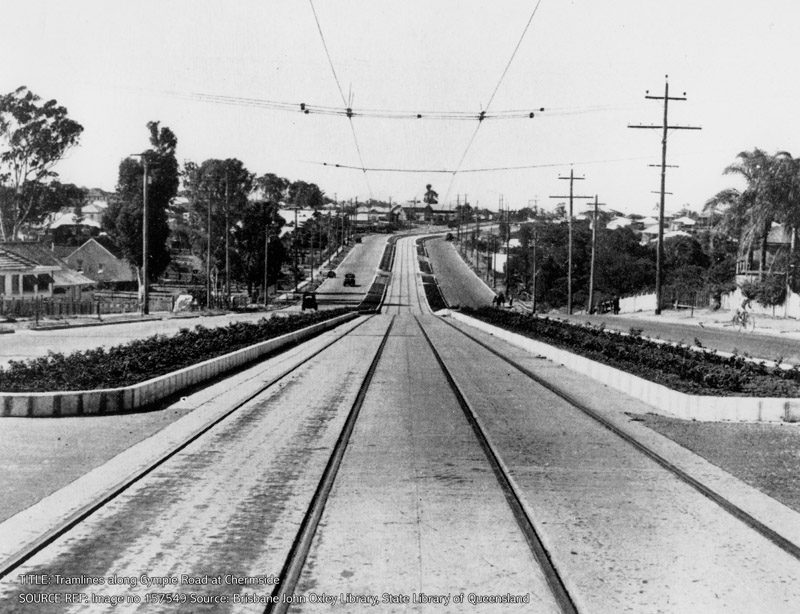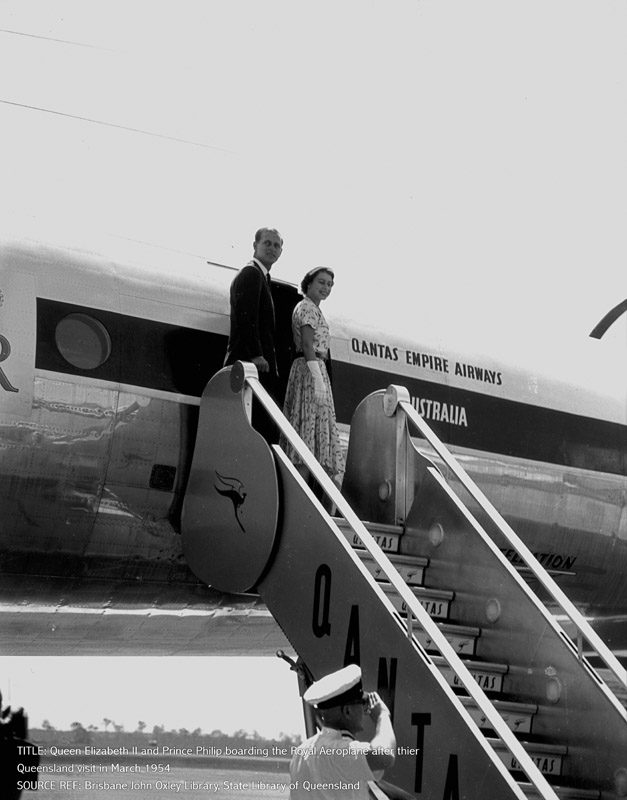Memory Lane – EMU West Wall
Ansett Airplane at Eagle Farm Airport – 1972
Yugara Country
The name of Reginald Ansett was associated with airline history from 1935 until the 1980s. His company operated Ansett Airways from 1937 and expanded during World War II when domestic services ceased but charter work was available for the Federal Government and the American Armed Forces. In 1957 Ansett merged with Australian National Airways, operating as Ansett-ANA until a name change to Ansett Airlines of Australia in 1968.
The Douglas DC 9 shown in this image went into service in 1967. Ansett used the planes for passenger services during the day and for cargo services at night. Until a new domestic terminal was opened in 1988 passengers alighted from the aircraft on to the tarmac and walked to the terminal.
Tramlines along Gympie Road at Chermside
Turrbal Country
On 24th July 1958 Council approved the erection of directory boards at the city tram stops in Queen and Adelaide Streets. On 27 August 1959 the Courier Mail reported that a start had been made that week with the erection of the signs. They allowed the public, especially those who were not familiar with Brisbane trams, to readily recognise the tram required. One of these signs is on display at the Tramway Museum.
Prior to the use of this elevated signal cabin, point boys switched the points of the tram tracks in the middle of the street and signalmen used flags to indicate to motormen when to proceed. This became a controversial issue as there were many injuries and even fatalities as the volume of motor traffic increased over the years.
Two signal cabins were erected at both ends of Petrie Bight in 1925 and were so successful that they became an item of tramway infrastructure. GR Steer, the General Manager of the Tramways Department, announced the operation of the Valley Junction signal lamps on 19 May 1927, when ‘the points in the track and all signals will be working from the elevated cabin and the men taken off the street’. The apparatus was so designed that there could be no conflicting signals and the movement of the points was by an electrically controlled hydraulic mechanism set in the roadway. The system ceased operation on 13 April 1969.
Last day of trams in Brisbane, 13 April 1969. This date is considered by many of Brisbane’s citizens as ‘one of Brisbane’s blackest days’. On this date the tramway system that had served the people well for 84 years ceased to operate. The decision in 1968 to adopt the freeway system of roads for Brisbane under the Wilbur Smith Plan meant the discontinuation of trams in favour of a motor bus system. The replacement of the Victoria Bridge was in progress at this time and the fate of trams was sealed when the concrete structure was built without tram tracks. Some of the trams have been saved for posterity by the Brisbane Tramway Museum which was officially opened on 10 August 1980.
Queen Elizabeth II and Prince Philip boarding the Royal Aeroplane after their Queensland visit in 1954
Yugara and Turrbal Country
Princess Elizabeth was en-route to Australia when her father died in 1952 and she returned to England. As a new monarch, Queen Elizabeth II and Prince Philip, Duke of Edinburgh, toured Australia in 1954. The first visit to use air travel, it was an extensive and exhausting tour, including 33 flights, 130 hours of driving, train and boat travel. All capitals (except Darwin) and 70 country towns were visited, allowing about 75 per cent of the population to view the new Queen.
The Queensland portion of the “Royal Progress” was from 9 to 15 March 1954 and included Brisbane, Bundaberg, Oakey, Toowoomba, Townsville, Cairns, Mackay and Rockhampton as well as a day of rest on the Great Barrier Reef. Public holidays were declared by an Act of Parliament; buildings were painted, decorated and illuminated for the visit and in all towns people turned out in droves to see the royals. In Brisbane a civic welcome, state reception, investiture, Executive Council meeting and Lord Mayor’s Ball were held. The tour was described as a magnificent success which ‘left an imperishable memory for Australians of our Queen and her husband.
Source: Royal Visits to Queensland: An historical essay – Stories from the Archives



